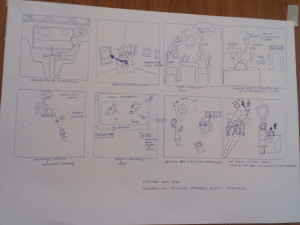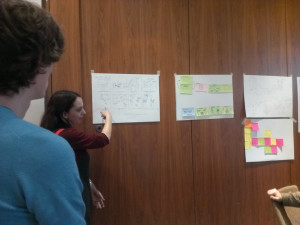Narrative scenarios are used to establish the details of how the proposed design is likely to be used. They challenge the participants to carefully map out how an intended design would be used and in doing so, the completed narrative scenarios can help envision how the product/service might be used in real life situations.
As part of meSch, the narrative scenario method was used for the production of detailed storyboards depicting different use cases for the authoring tool. In this situation, we wanted to imagine how the yet-to-be developed authoring tool might be used by 3 different user groups of cultural heritage professionals: those who have never used technology before in exhibitions (beginner); those who have more experience using technology (expert);and those who intended to re-use a technology they already had (technology-push).
The activity began with a short presentation by the facilitator who gave a clear outline of the 3 different user groups (beginner, expert, tech-push). Following the presentation, the brief asked that each group of 3-5 participants collectively formulate a narrative scenario for how they would imagine one of the assigned user groups (beginner, expert, tech-push) would use the authoring tool. Four groups were formed: two groups developed a storyboard for the beginner scenario; one group developed a storyboard for the expert scenario; and one group developed a storyboard for the tech-push scenario.
With the aid of storyboard templates, each group was asked to visualise the use of the tool across eight scenes.
Read more about this activity as part of the meSch co-design workshop here.
This is an excerpt of the discussion around the envisaged scenarios:
Download the how-to sheet here.






